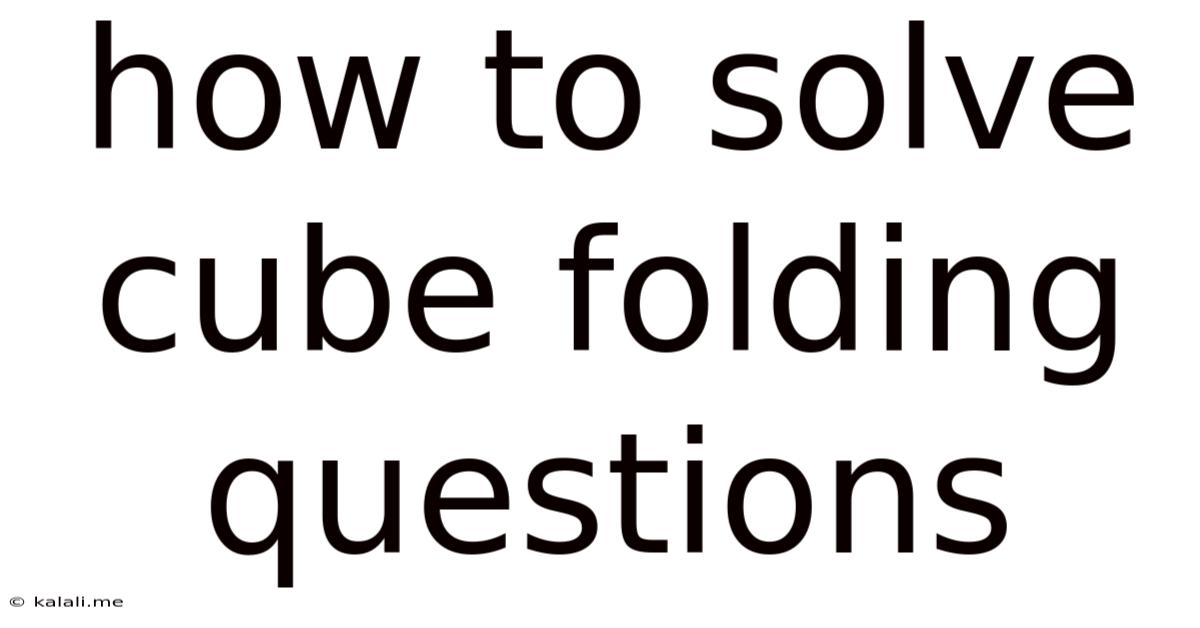How To Solve Cube Folding Questions
Kalali
Jun 11, 2025 · 3 min read

Table of Contents
How to Conquer Cube Folding Questions: A Step-by-Step Guide
Cube folding problems, often found in aptitude tests and puzzles, can seem daunting at first. They challenge your spatial reasoning skills, requiring you to visualize how a 2D net folds into a 3D cube. This article will equip you with a systematic approach to solve these questions efficiently and accurately, boosting your problem-solving confidence. Mastering this skill not only helps with tests but also enhances your overall analytical thinking.
Understanding the Basics: Nets and Cubes
Before tackling complex problems, let's define our terms. A net is a two-dimensional pattern that can be folded to form a three-dimensional shape, in this case, a cube. A cube has six faces, twelve edges, and eight vertices. Understanding the relationships between these elements is crucial. Each face of the unfolded net corresponds to a face of the folded cube. Adjacent faces in the net will be adjacent faces in the cube.
Strategies for Solving Cube Folding Questions
Several effective strategies can help you navigate cube folding questions. These strategies involve a combination of logical deduction and visualization techniques:
1. Identify Adjacent Faces:
This is the cornerstone of solving these problems. Look for faces in the net that share an edge. When folded, these faces will be adjacent on the cube. Practice identifying these adjacent pairs is key. Often, a single incorrectly identified adjacent pair will lead to an incorrect solution.
2. Eliminate Impossible Options:
Many cube folding questions present you with multiple-choice answers. Use the adjacent face rule to systematically eliminate options. If two faces are adjacent in the net but not adjacent in a given option, that option is incorrect. This process of elimination significantly narrows down the possibilities.
3. Visualize the Folding Process:
This is where practice comes in handy. Try to mentally fold the net in your mind. Start by identifying one face as the base and imagine how the other faces fold around it. Use your fingers to simulate the folding process if it helps. This hands-on approach can greatly enhance your visualization skills.
4. Use a Physical Model (Optional):
If you're struggling with visualization, consider using a physical model. Cut out the net from paper and physically fold it. This is especially helpful for more complex nets. This tactile approach can solidify your understanding of the relationship between the net and the cube.
5. Look for Key Features:
Some nets contain distinctive features, such as a particular pattern or a specific arrangement of faces. Identifying these features can provide clues to the correct folding configuration. For instance, look for faces that are diagonally opposite or those forming a continuous line.
6. Practice Regularly:
Like any skill, solving cube folding questions requires practice. The more you practice, the better you will become at visualizing the folding process and identifying adjacent faces quickly. Start with simpler nets and gradually progress to more complex ones. Online resources and puzzle books offer ample opportunities for practice.
Example Question and Solution
Let's consider a sample question: Which of the following nets can be folded to form a cube? (Imagine multiple nets are shown here – this is a simplified example).
By using the strategy above, focusing on adjacent faces and eliminating impossible options, you would be able to determine the correct net. Remember to carefully check for adjacent faces to avoid errors.
Conclusion: Mastering Spatial Reasoning
Cube folding questions assess your spatial reasoning and problem-solving skills. By employing the strategies outlined above – identifying adjacent faces, eliminating impossible options, visualizing the folding process, and practicing regularly – you can significantly improve your ability to solve these puzzles accurately and efficiently. Mastering this skill will benefit you not only in aptitude tests but also in various real-world situations requiring spatial awareness and analytical thinking.
Latest Posts
Latest Posts
-
How Many Grams Is In A Pint
Jul 01, 2025
-
Lyrics To The Song Stand By Donnie Mcclurkin
Jul 01, 2025
-
How Much Is 3 Quarts Of Water
Jul 01, 2025
-
How Many Cups Is 1 Pound Of Pasta
Jul 01, 2025
-
Or Or Or Or Or Or Or Or Or
Jul 01, 2025
Related Post
Thank you for visiting our website which covers about How To Solve Cube Folding Questions . We hope the information provided has been useful to you. Feel free to contact us if you have any questions or need further assistance. See you next time and don't miss to bookmark.